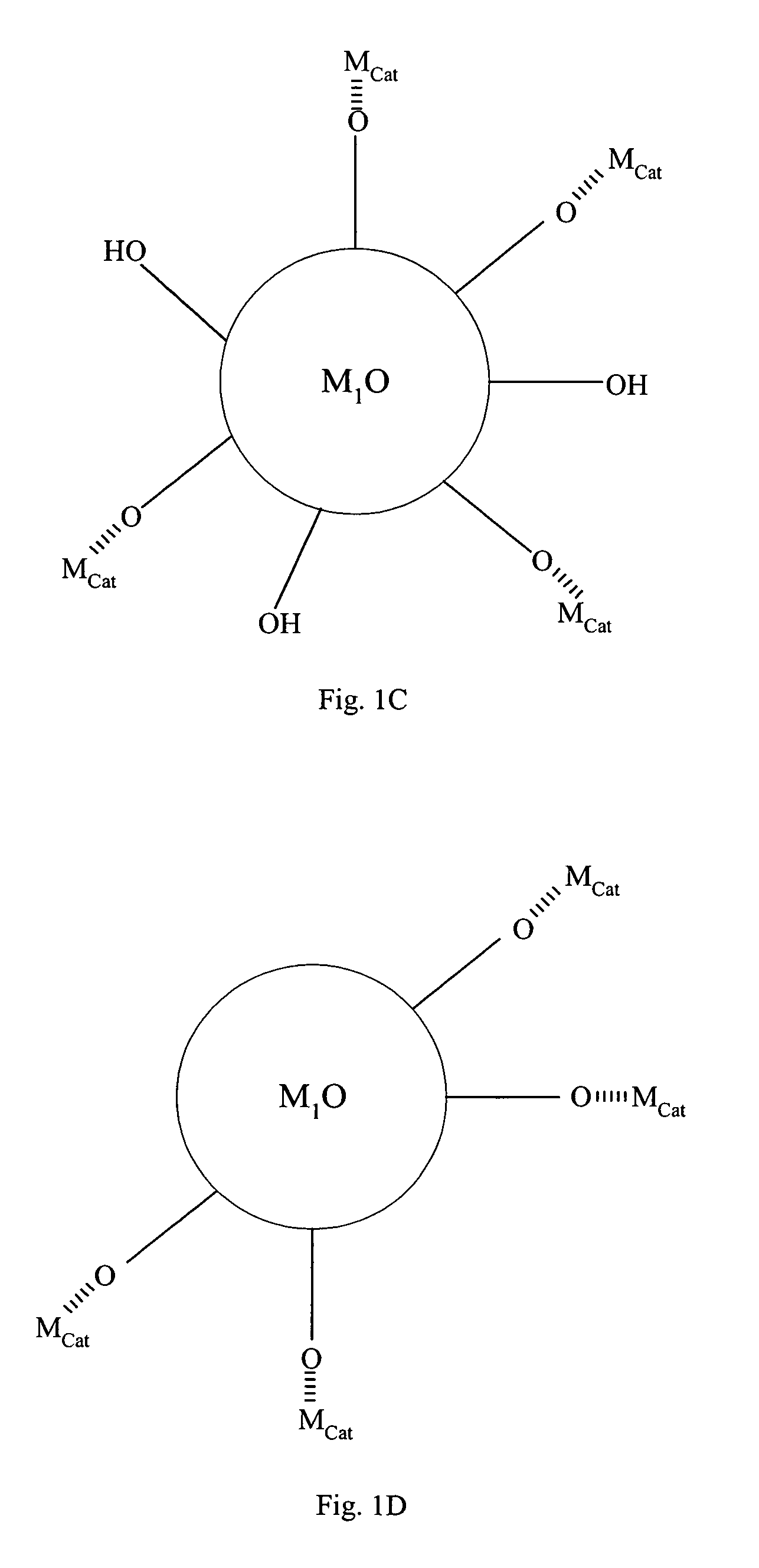Catalytic material and method of production thereof
a technology of catalysts and catalyst materials, applied in the direction of physical/chemical process catalysts, combustible gas purification/modification, separation processes, etc., can solve the problems of low catalytic activity at low temperatures, harmful to human health, and contaminants in the air, and achieve high metal dispersion
- Summary
- Abstract
- Description
- Claims
- Application Information
AI Technical Summary
Benefits of technology
Problems solved by technology
Method used
Image
Examples
example 1
The Catalytic Intermediates and Final Products
[0067]Referring to FIG. 1, compound (A) is a first metal oxide crystal (M1O) serving as the catalyst support. The size of (A) is about 3 to about 25 nm, preferably, the size is about 3 to about 16 nm and, more preferably, about 6 to about 15 nm. Preferably, the crystallinity of (A) is better than about 70% and the crystal structure of (A) can be primarily anatase. Up to about 30% rutile can be tolerated.
[0068]Compound (B) comprises a metal precursor, depicted as {circle around (Mcat)} in FIG. 1, deposited on compound (A). Preferably, the metal precursor is adsorbed to a portion of the hydroxyl groups on compound (A). Preferably, the loading of the metal precursor is in the range of about 0.01 to about 2.5 wt. %.
[0069]Compound (C) comprises active metal catalysts Mcat which is converted from the metal precursors of compound (B). Preferably, the metal catalyst is adsorbed to a portion of the hydroxyl groups on compound (A). The loading of ...
example 2
Schematic Process of Producing the Catalytic Material
[0072]FIG. 2 summarizes the process of making the invented metal catalyst in accordance with the preferred embodiments of the current invention. The first step 21 is to form an amorphous first metal oxide gel sphere. In step 22, the gel sphere is crystallized in a tightly controlled condition such that the first metal oxide crystals are formed with surface hydration optimized for metal deposition. Step 23 comprises cleaning the contaminants on the first metal oxide surface and adjusting surface hydration level to about 5 to about 100 mg / g dry solid, forming compound (A). Step 24 comprises depositing a metal precursor onto (A), forming compound (B). Step 25 comprises converting the metal precursor on compound (B) into active metal catalyst, forming compound (C). Step 26 comprises removing excess hydration on compound (C), forming compound (D), such that the metal catalyst does not migrate on the surface of first metal oxide support...
example 3
Forming (TiOx(OH)y) (Corresponding to Step 21)
[0074]Preferably, in TiOx(OH)y, x is an integer from 0 to 2, and y is an integer with the value of 4−2x. More preferably, TiOx(OH)y comprises Ti(OH)4, TiO(OH)2, TiO2 species or mixtures thereof.
Procedure:
[0075](1) Titanium isopropoxide (TIP, Aldrich) was dissolved in isopropanol at room temperature to give a solution containing about 0.1 to about 20 mM TIP.[0076](2) TIP-isopropanol solution was added drop by drop into a water-isopropanol solution (containing about 0.01 to about 2.5 M water) with constant stirring at a fixed temperature between 25-80° C.[0077](3) The resulting precipitates were filtered, washed, and dried at room temperature for later use.
PUM
| Property | Measurement | Unit |
|---|---|---|
| size | aaaaa | aaaaa |
| size | aaaaa | aaaaa |
| size | aaaaa | aaaaa |
Abstract
Description
Claims
Application Information
 Login to View More
Login to View More - R&D
- Intellectual Property
- Life Sciences
- Materials
- Tech Scout
- Unparalleled Data Quality
- Higher Quality Content
- 60% Fewer Hallucinations
Browse by: Latest US Patents, China's latest patents, Technical Efficacy Thesaurus, Application Domain, Technology Topic, Popular Technical Reports.
© 2025 PatSnap. All rights reserved.Legal|Privacy policy|Modern Slavery Act Transparency Statement|Sitemap|About US| Contact US: help@patsnap.com



